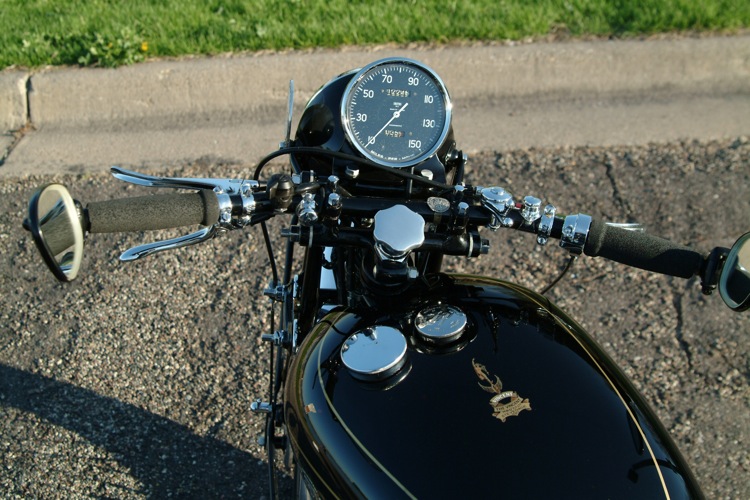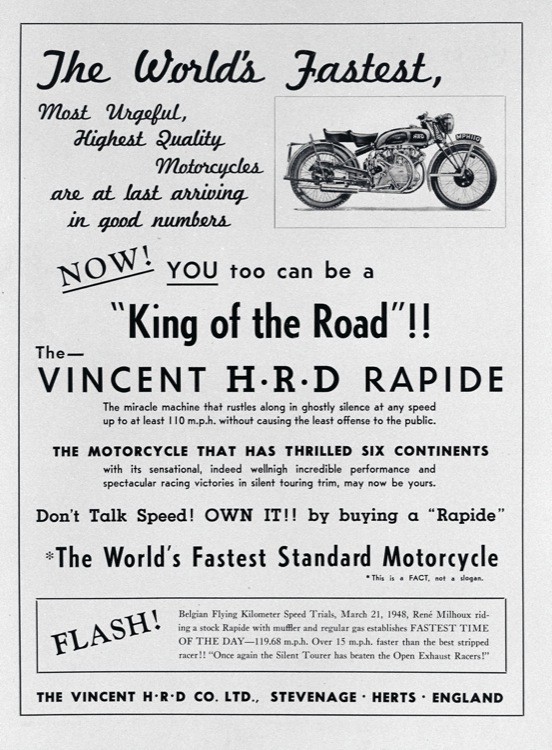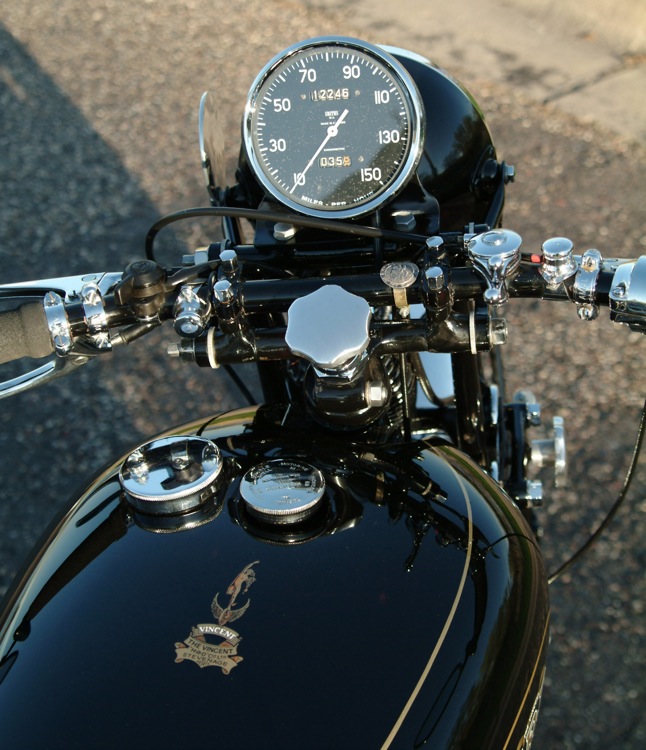Vincent HRD Motorcycles

"The World's Fastest Standard Motorcycle" - for over 10 years, this simple phrase was the cornerstone of Vincent HRD's advertising campaign.
In the immediate post-World War II years, most motorcycles were considered extremely fast if they could hit 90 mph. This was true of the two surviving American brands, Harley and Indian, as well as machines from England and the Continent. "Breaking the ton," one hundred miles per hour, was not in the cards for most street motorcycles.
In contrast, the two 1000cc V-twins from Vincent, the Rapide and the Black Shadow, would run 110 and 125 mph respectively. Compared to today's machines, this may not seem very impressive, but consider this. The Black Shadow, at 125 mph, was more than 25 percent faster than any other stock machine on the road at the time. In modern comparisons that would be like having a Suzuki Hayabusa running 232 mph and Kawasaki's top dog, the ZX-14, topping out at only 186 mph.
Company president Philip Vincent's goal was not only to build the world's fastest production machine, but one with long legs capable of eating up the miles. And with the assistance of his brilliant Australian-born designer, Phil Irving, he did just that.
Philip Vincent purchased the HRD firm in 1927 from Howard R. Davies, hence the HRD moniker. Before and after the purchase, HRD built machines with engines sourced from Rudge, Villers, and J.A.P. However, these engines weren't always up to Philip Vincent's demanding specifications, and eventually the company decided to design and build their own 500cc single cylinder engine. Thus, the first complete HRD motorcycle, designed by the two "Phils," hit the streets in the fall of 1934.
As successful as this new engine was, Vincent and Irving realized they needed something with a bit more steam. How their historic V-twin engine came to be is a story that has circulated among the Vincent faithful ever since.

One warm summer day in 1936, chief engineer Phil Irving had several engine blueprints from their newly designed single scattered about his drawing board. His task that day was to make only a few minor design changes. But Irving noticed how two engine drawings, laying over one another, formed a V. The inspiration for Vincent's world-beating machine was born.
In less than a month, the company's first V-twin powered machine was on the road. Some onlookers were a bit skeptical. The machine certainly looked very businesslike, but could it haul the mail? During its first road test, after the machine was thoroughly warmed up, the test rider twisted the throttle to the stops. The newly christened "Series A" Rapide leaped forward. When it topped out, 108 mph had registered on the clock. This impressive number was backed up several weeks later, when, at England's historic Brooklands track, a second Rapide was clocked at 112 mph. This kind of performance stunned the motoring world. At the time, there wasn't a production vehicle on two, or even four, wheels that could match the Rapide's performance.
Unfortunately, World War II put the brakes on civilian motorcycle production. By 1939, less than 80 Series A Rapides had rolled out of the factory gates. During the war years, when time allowed, Phil Irving began a total redesign of the 1000cc V-twin, which would become known as the Series B Sports Rapide. Philip Vincent's "well-heeled" customers quickly snapped up these high-performance machines.
Soon Rapide owners had a monkey on their backs and were asking for even more power! With a few basic hot-rod tricks, the Black Shadow was introduced in the Spring of 1948. Producing 22 percent more power than the Rapide, a Black Shadow would run an honest 125 mph. Or you could order the Black Lightning, Vincent's factory racer, to go even faster. The great Rollie Free, dressed only in a bathing suit, shower cap and sneakers, piloted one across Bonneville's salt at a tick over 150 mph.
But, you may ask, does the Vincent live up to its reputation? Keeping in mind over 60 years have passed since the machine was designed, and though risking my 25-year membership in the Vincent Owner Club, I can positively say, "That depends." Stacked up against modern machines, such as an FJR 1300, the Vincent appears almost absurd.
For starters, there isn't one - not electric at least. Your right leg does all the work. There's also no ignition key, yet the machine has a great built-in security system. It's called the "starting drill." A feature shared by many vintage bikes, it goes like this: open the fuel petcock, set the chokes, tickle the carbs, pull in the compression release and give the machine a healthy kick. Then, during the mid-point of your swing drop the compression release. If the stars are aligned, the mighty V-twin might light off. If not, keep repeating the drill until it fires up or the paramedics arrive.
Philip Vincent's dream of building a machine with long legs still has some merit. The machine's high-speed performance is truly impressive. This beast will run at 70 mph all day and never break a sweat. However, your body might not survive eight hours in the saddle. A full day's ride makes you realize how far we have come with suspension compliance.
Another nit to pick - stopping performance. Vincent riders always plan ahead, way ahead. Even though it is fitted with two seven-inch drum brakes on each wheel (revolutionary in its day), a lot of pavement is chewed up before the machine comes to rest.
All of these shortcomings vanish when you add in the "wow" factor however. Few machines can match a Vincent in this respect. I even had one yahoo leap out in front of me in downtown Sturgis while I was at speed. He was screaming, "I need a picture of your bike!" If the adoring fans only knew the trials that come part and parcel with ownership. Still, I can't deny that I have had loads of fun over the years with this rock-star image. In that respect, the joys far outweigh the pain.
Technical Specs
Engine
50º V-twin, 998cc, overhead valve, twin cams,
twin carburetors, four-speed gearbox
Horsepower
Rapide: 45
Black Shadow: 55
Dimensions
Wheelbase: 56"
Seat Height: 30"
Dry Weight: 455lbs
Fuel Capacity: 4.2gal













